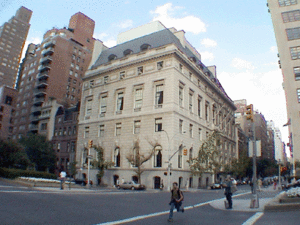Union Club
Founded in 1836 the Union Club of the City of New York is the oldest club in North America. Located on E. 69th Street and Park Avenue in New York City it occupies a National Historic Landmark building opened on August 28 1933 to the design of Delano and Aldrich. This is the Club's sixth clubhouse and the third built for the members. The prior two clubhouses were at Fifth Avenue and 21st Street, occupied from 1855 to 1903, and the northeast corner of Fifth Avenue and 51st Street, occupied from 1903 to 1933.
- Offshoots
- Formation of "The Knick"
The Union Club was known as particularly conservative. According to the historian John Steele Gordon, a member of the club, it did not expel its Confederate members during the Civil War years.
Some members took exception to this and withdrew to found the Union League Club, now at 38th and Park.
In the 1870s, other members, who thought the Union’s standards of admission had fallen, went off to form the Knickerbocker Club, now at 62nd and Fifth Avenue. The Brook and Metropolitan Clubs were also offshoots.
From website
While some social clubs such as the Metropolitan on Fifth Avenue at 60th Street and the University on Fifth Avenue at 54th Street have larger and more impressive exteriors, the Union Club boasts the most elegant interiors.
Founded in 1836, it is the city's oldest social club and its male membership has been largely drawn from the city's most socially prominent Protestant families.
The club decided to move from its Fifth Avenue & 51st Street location in 1927 in its fifth move and this clubhouse, designed by Delano & Aldrich, opened in 1933.
The architects were experts in Georgian-style designs and their other important Upper East Side commissions include the Knickerbocker Club, the Colony Club, the Third Church of Christ, Scientist (see The City Review article) and the Willard Straight house. All of these were red-brick "American Colonial" style structures, but the Union Club is clad entirely in limestone.
In his book, "Touring the Upper East Side, Walks in Five Historic Districts" (The New York Landmarks Conservancy, 1995), Andrew S. Dolkart remarks that "the dull, somewhat overblown exterior is designed in an English Renaissance manner that alludes to the gentlemen's clubs of London, but lacks the finesse of the clubs on Pall Mall." Such an assessment may be right about finesse, but is a bit harsh as Delano & Aldrich's design is very elegant and very refined.
In their great book, "New York 1930, Architecture and Urbanism Between The Two World Wars" (Rizzoli International, 1987), Robert A. M. Stern, Gregory Gilmartin and Thomas Mellins, provide the following commentary about this building:
"...[it] was one of the last great monuments of the American Renaissance and the last in a chain of imposing, Classicly inspired clubhouses that extended back to McKim, Mead & White's Century Club of 1891. Regreattably, the new Union Club replaced a minor masterpiece of the pre-war era, McKim, Mead & White's Geraldyn Redmond house. With bittersweet mockery Standford White's son, the architect Lawrence Grant White, reputedly wrote to Delano & Aldrich requesting that the following inscription be placed above the front door: 'Conceived by the Genius of McKim, Mead & White. Destroyed by the Fury of Delano & Aldrich.' The quiet limestone Georgian design clothed a complexly organized, elegantly proportioned set of Classical rooms that enabled members to enjoy all of the comforts of twentieth-century life, including ticker-tape reports of stock-market transactions, pneumatic-tube service from Wall Street, as well as year-round air-conditioning and humidification. William Delano's plan was based in part on his design for the Willard Straight house of 1913, and his Kinickerbocker Club of the same year. Brilliantly focused on a double-height central entrance rotuda, its cross-axial hallways were raised a level above the street and reached by a gracious staircase. The second floor, an entresol, contained private dining rooms, while the third, returing to the grand scale of the first, contained the principal dining room as well as the library. Bedrooms were located on the fourth floor, their comparatively small windows alternating with elaborately carved panels to form a frieze below the cornice, while squash courts and locker rooms were housed in a high masard roof. The bold simplicity of the exterior contrasted with the intricacy of the interior spaces; vaulted ceilings ranged form the deeply coffered dome over the entrance rotounda to the shallow coffered vault of the north louge. Ceiling rosettes concealed the air-conditioning grilles in the main lounge and writing room. Elaborate cyrstal chandeliers from the previous clubhouse were usedin the card room, while simple pendant globes of a distinctly Modern Scandinavian character were the principal ornament of the English oak library. The dressing room lounge on the sports floor was treated as a tented room furnished with rattan."
See also
- Gentlemen's club
- List of American gentlemen's clubs
- List of Australian gentlemen's clubs
- List of London's gentlemen's clubs
Chat rooms • What links here • Copyright info • Contact information • Category:Root
